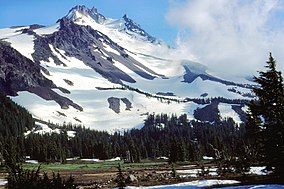Mount Jefferson Wilderness
| Mount Jefferson Wilderness | |
|---|---|
|
IUCN category Ib (wilderness area)
|
|

Jefferson Park Meadows, Mount Jefferson Wilderness
|
|
| Location | Linn / Jefferson / Marion counties, Oregon, United States |
| Nearest city | Sisters, Oregon |
| Coordinates | 44°40′31.05″N 121°47′54.40″W / 44.6752917°N 121.7984444°WCoordinates: 44°40′31.05″N 121°47′54.40″W / 44.6752917°N 121.7984444°W |
| Area | 111,177 acres (449.9 km2) |
| Established | 1968 |
| Governing body | United States Forest Service |
The Mount Jefferson Wilderness is a wilderness area located on and around Mount Jefferson in the central Cascade Range of Oregon in the United States. It is situated where the Willamette, Deschutes, and Mount Hood National Forests meet. Mount Jefferson Wilderness is the second most visited Oregon wilderness area after the Three Sisters Wilderness.
At 10,497 feet (3,199 m), Mount Jefferson is the second tallest mountain in Oregon. It is a stratovolcano with slopes mantled by five glaciers - Whitewater, Waldo, Milk Creek, Russell, and Jefferson Park. Three Fingered Jack is a heavily eroded and deeply glaciated shield volcano and consists mainly of basaltic andesite lava. At 7,841 feet (2,390 m), it is made up of the solidified lava plug flanked by ridges of the old volcano's subsidiary lava dikes and lies at the southern end of the Mount Jefferson Wilderness. Other geographic features of the wilderness include steep talus slopes, rock outcrops, and alpine meadows.
Several lakes are situated within the wilderness area, including Marion Lake, Duffy Lake, Santiam Lake and Wasco Lake.
Vegetation in Mount Jefferson Wilderness is predominantly Douglas-fir, Pacific silver fir, sub-alpine fir, mountain hemlock, lodgepole pine, ponderosa pine, several species of false cedars including, Alaska-cedar, incense cedar, and western redcedar as well as species such as vine maple, huckleberry and rhododendron.Lupine, red paintbrush, bear grass, and various species of lily are also common in the wilderness.
...
Wikipedia

